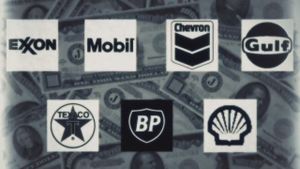Achnacarry Agreement
 Achnacarry Castle then owned by Henry Deterding, since WW2 closely connected to the British Commandos. | |
| Interest of | Red Line Agreement |
The Achnacarry Agreement, also known as the As-Is-Agreement, was a top secret agreement from 1928 to form an oil cartel of all the major oil producers of the time, to limit "excessive competition". The governments at the time ratified this agreement. The public did not find out about this cartel until 1952.
Contents
The Participants
The agreement was made on August 18, 1928 at a meeting of representatives of oil production companies in Achnacarry Castle, owned by Deterding. Participants included:
- John Cadman of the Anglo-Persian Oil Company
- Henri Deterding from the Royal Dutch Shell
- Walter Teagle from Standard Oil of New Jersey
The so-called "Seven Sisters" belonged to the cartel:
- Standard Oil of New Jersey
- Mobil (Standard Oil of New York)
- Gulf Oil
- Texaco
- Standard Oil of California
- Royal Dutch Shell
- Anglo-Persian Oil Company
The Agreement
Price wars among major oil companies in the 1920s, most significantly one in India between Standard Oil of New York and a subsidiary of Royal Dutch Shell, threatened major oil company profits, especially those from relatively high-cost production in the United States.
The As-Is Agreement, (available online[1]), consisted of seven "principles" to limit "excessive competition" that had led to enormous overproduction, by dividing markets, fixing prices, and limiting the expansion of production capacity. The agreement affected the development of oil production capacity in the Middle East by limiting price competition in product markets and, as a result, supporting the prices of products made from high-cost, primarily American, crude oil. This strategy was implemented as a "basing-point" system under which all sellers calculated delivered prices as the sum of FOB prices at one or more specific locations—basing points—plus a standardized freight charge from that point to the point of delivery. Such a system is very effective because it ensures that all sellers quote the same prices and that producers with low costs cannot use that advantage to expand their market shares by passing on the low costs.
For the crude oil of the Middle East, which could be extracted with little effort, this system meant that the development of production capacities was delayed by the exploitation of existing concessions until the Second World War and reserves were exploited in the USA and Canada.
The resulting division of production shares between Middle Eastern countries and others increased anticolonial and anti-Western feelings among the populations of many Middle Eastern states, most notably Iraq and Iran. It also established a pattern for ensuring oil profits by exercising market control that the members of the Organization of Petroleum Exporting Countries later tried to emulate.[2][3]
Exposure
This as-is agreement was revealed in 1952 in a report entitled The International Petroleum Cartel by the Federal Trade Commission to the subcommittee of the US Senate.[4]
Wikipedia
Per January 2020, Wikipedia does not have an article on this imporant event, and is only mentioned in passing in other articles.
Known Participants
6 of the 8 of the participants already have pages here:
| Participant | Description |
|---|---|
| British Petroleum | |
| John Cadman | Director of the Anglo-Persian Oil Company who aimed for cartel control of world oil market |
| Chevron | |
| Henri Deterding | Anglo-Dutch oil tycoon, one of the richest men in the world, oil cartel instigator, very early sponsor of Hitler |
| ExxonMobil | |
| Shell | Biggest Dutch company. Caused trillions in damage due to fracking in Groningen. Convicted worldwide for crimes against locals. Employs hitmen and deep state operatives in African countries. Mislead shareholders for up to $1bn. |
Ratings
References
- ↑ https://web.archive.org/web/20111020185811/http://www.mtholyoke.edu/acad/intrel/energy/achnacarry.htm
- ↑ Edith T Penrose: The Large International Firm in DevelopingCountries: The International Petroleum Industry. Westport, CT: Greenwood Press, 1976.
- ↑ Anthony Sampson: The Seven Sisters: The Great Oil Companies and the World They Shaped. New York: Bantam, 1991.
- ↑ United States Congress. Senate. Select Committee on Small Business. Subcommittee on Monopoly. The International Petroleum Cartel: Staff Report to the Federal Trade Commission. 82nd Congress, 2nd session. Washington, DC: United States Government Printing Office, 1952.
